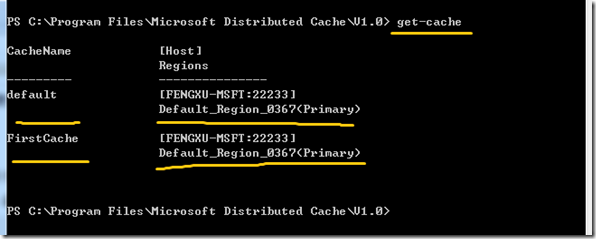经过前几篇文章的理论阐述后,现在开始演练下
一、缓存服务准备
我没有太多的资源,所有东西都安装在我的PC机上(这台笔记本所有权不是我的,历史悠久,还掉了一个键,穷啊,只能接上外接键盘).使用默认设置安装过完成。
用安装后自带的PowerShell工具添加一个名为“FirstCache”缓存。命令好下:
New-Cache FirstCache
用Get-CacheHost命令查看现有主机:
主机名为:FENGXU-MSFT,端口号是默认的22233,服务名为默认的:DistributedCacheService
用Get-Cache命令查看现有的缓存
可以看到群集中有两个缓存,default是安装后默认的一个缓存,FirstCache是刚刚自己创建的缓存
二、缓存基本API使用
新建一个工程,添加上一篇中的四个程序集的引用,配置app.config文件如下
app.config<?xml version="1.0"?> <configuration> <!--configSections must be the FIRST element --> <configSections> <!-- required to read the <dataCacheClient> element --> <section name="dataCacheClient" type="Microsoft.Data.Caching.DataCacheClientSection, CacheBaseLibrary" allowLocation="true" allowDefinition="Everywhere"/> <!-- required to read the <fabric> element, when present --> <section name="fabric" type="System.Data.Fabric.Common.ConfigFile, FabricCommon" allowLocation="true" allowDefinition="Everywhere"/> </configSections> <!-- routing client--> <dataCacheClient deployment="simple" timeout="30000"> <!-- (optional) specify local cache <localCache isEnabled="true" sync="TTLBased" objectCount="100000" ttlValue="300" /> --> <!--(optional) specify cache notifications poll interval <clientNotification pollInterval="300" /> --> <!-- cache host(s) --> <hosts> <host name="FENGXU-MSFT" cachePort="22233" cacheHostName="DistributedCacheService"/> </hosts> </dataCacheClient> <startup><supportedRuntime version="v4.0" sku=".NETFramework,Version=v4.0"/></startup></configuration>
这里使用的是本地缓存,在host节点中host name 是cache hosts的主机名,cacheHostName是服务名。
在代码中的基本读写
cache client基本使用using System; using System.Collections.Generic; using System.Linq; using System.Text; //添?加ó命ü名?空?间? using Microsoft.Data.Caching; namespace VolocityDemo { class BaseMethod { DataCacheFactory factory; public BaseMethod() { //方?法ぁ?一?:阰使?用?默?认?配?置?创洹?建¨ factory = new DataCacheFactory(); //代洙?码?中D动ˉ态?指?定¨ //方?法ぁ?二t:阰declare array for cache host(s) //DataCacheServerEndpoint[] servers = new DataCacheServerEndpoint[1]; ////specify cache host(s) //servers[0] = new DataCacheServerEndpoint("FENGXU-MSFT", // 22233, "DistributedCacheService"); //factory = new DataCacheFactory(servers, false, false); } ~BaseMethod() { factory.Dispose(); } public void Test() { DataCache dataCache = factory.GetCache("FirstCache"); //添?加ó缓o存?对?象ó if (dataCache.Get("Time1") == null) { dataCache.Add("Time1", DateTime.Now); } Console.WriteLine(string.Format("读á取?缓o存?对?象óTime1:阰{0:yyyy-MM-dd HH:mm:ss}", dataCache.Get("Time1"))); dataCache.Put("Time1", DateTime.Now); Console.WriteLine(string.Format("读á取?更ü新?的?缓o存?对?象óTime1:阰{0:yyyy-MM-dd HH:mm:ss}", dataCache.Get("Time1"))); //移?除y对?象ó //remove object in cache using array notation dataCache["Time1"] = null; //remove object in cache using key "Key0" //dataCache.Remove("Key0"); } } }
当缓存群集重启时,缓存服务将从配置文件中加载现有的缓存配置,FirstCache将仍然存在。还可以用powershell工具Export-CacheClusterConfig命令先将缓存的配置先用导出来,再用Import-CacheClusterConfig命令导出来
示例中导出的配置如下:

 导出的配置<?xml version="1.0" encoding="utf-8"?>
<configuration>
<configSections>
<section name="dataCache" type="Microsoft.Data.Caching.DataCacheSection, CacheBaseLibrary, Version=1.0.0.0, Culture=neutral, PublicKeyToken=89845dcd8080cc91" />
</configSections>
<dataCache cluster="demoCache" size="Small">
<caches>
<cache type="partitioned" consistency="strong" name="default">
<policy>
<eviction type="lru" />
<expiration defaultTTL="10" isExpirable="true" />
</policy>
</cache>
<cache type="partitioned" consistency="strong" name="FirstCache">
<policy>
<eviction type="lru" />
<expiration defaultTTL="10" isExpirable="true" />
</policy>
</cache>
</caches>
<hosts>
<host clusterPort="22234" hostId="1743595319" size="1228" quorumHost="true"
name="FENGXU-MSFT" cacheHostName="DistributedCacheService"
cachePort="22233" />
</hosts>
<advancedProperties>
<partitionStoreConnectionSettings providerName="System.Data.SqlServerCe.3.5"
connectionString="\\127.0.0.1\MicrosoftDistributeCache\ConfigStore.sdf" />
</advancedProperties>
</dataCache>
</configuration>
导出的配置<?xml version="1.0" encoding="utf-8"?>
<configuration>
<configSections>
<section name="dataCache" type="Microsoft.Data.Caching.DataCacheSection, CacheBaseLibrary, Version=1.0.0.0, Culture=neutral, PublicKeyToken=89845dcd8080cc91" />
</configSections>
<dataCache cluster="demoCache" size="Small">
<caches>
<cache type="partitioned" consistency="strong" name="default">
<policy>
<eviction type="lru" />
<expiration defaultTTL="10" isExpirable="true" />
</policy>
</cache>
<cache type="partitioned" consistency="strong" name="FirstCache">
<policy>
<eviction type="lru" />
<expiration defaultTTL="10" isExpirable="true" />
</policy>
</cache>
</caches>
<hosts>
<host clusterPort="22234" hostId="1743595319" size="1228" quorumHost="true"
name="FENGXU-MSFT" cacheHostName="DistributedCacheService"
cachePort="22233" />
</hosts>
<advancedProperties>
<partitionStoreConnectionSettings providerName="System.Data.SqlServerCe.3.5"
connectionString="\\127.0.0.1\MicrosoftDistributeCache\ConfigStore.sdf" />
</advancedProperties>
</dataCache>
</configuration>

